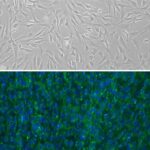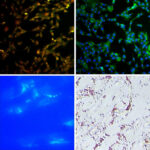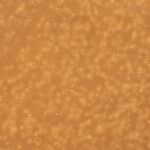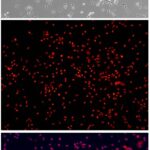Human Epidermal Keratinocytes: HEK
Description
Human Epidermal Keratinocytes (HEK) provide an excellent model to study epithelial function and disease, skin biology, toxicology and HPV infection. When grown on inserts and provided a liquid/air interface, they differentiate into a stratified squamous epithelium, forming a physiological 3D tissue. HEK comprise 90 % of all cells in the epidermis, the outermost skin layer. They produce a barrier, the intermediate filament keratin. Keratinocytes obtain melanin from melanocytes (HEM) and store it as protection from UV radiation. We highly recommend optimized Human EpiVita Media to enhance the performance and in vitro lifespan of HEK.
Click thumbnails for more videos of HEK in action:
HEK from Cell Applications, Inc. have been utilized in numerous research publications, for example in basic research to investigate mechanisms of cell senescence and develop ways to extend cell life span. Others have used HEK to design a method to isolate proteins for use in basic research, and show higher relevance of primary keratinocytes when compared to key differences exhibited by immortalized keratinocyte cell lines. Pharmaceutical companies employ HEK to provide in vitro human skin models that assess effects of cosmetic formulations or anti-inflammatory properties of proposed anti-psoriasis drugs. Translational research on keratinocytes benefits from their ability to model the wound healing response, or help develop serum tests for patients with blistering diseases. HEK are also utilized to understand aggressiveness of cancer phenotypes, investigate compounds for potential topical melanoma treatments, and even develop siRNA therapy targeting oncogenes. In addition, HEK help unravel the oncogenic potential of HPV and test approaches for treating HPV lesions.
Details
| Tissue | Normal healthy human foreskin or adult skin | |
|---|---|---|
| QC | No bacteria, yeast, fungi, mycoplasma, virus | |
| Bioassay | Attach, spread, proliferate in Growth Med | |
| Cryovial | 500,000 HEK (Primary culture) frozen in Basal Medium w/ 10% FBS, 10% DMSO | |
| Kit | Cryovial HEK (102-05), Epi-Vita Growth Medium (141-500a for adult; 141-500 for fetal/neonatal), Subcltr Rgnt Kit (090K) | |
| Proliferating | In Serum-Fr Gr Med, psg 1, flasks or plates | |
| Doublings | At least 16 in keratinocyte media | |
| Applications | Laboratory research use only (RUO). Not for human, clinical, diagnostic or veterinary use. |
Resources
FAQs
Need More Help?
Visit our comprehensive FAQ page for detailed answers to common questions.
Need More Help?
Visit our comprehensive FAQ page for detailed answers to common questions.
Primary Cell FAQsCitations
Extended Products
Human Epidermal Cell Growth Medium, without Calcium: EpiVita Growth Medium without calcium. Calcium must be added to support cell growth.
Human Epidermal Cell Growth Medium Kit: EpiVita Growth Medium Kit without calcium. Calcium must be added to support cell growth.
Human Epidermal Cell Basal Medium, without Calcium: Basal medium without calcium
Human Epidermal Cell Growth Supplement: EpiVita Growth Supplement without calcium. Calcium must be added to support cell growth.
Human EpiVita Basal Medium: Basal medium (contains no growth supplement). Add GS before use.
Human EpiVita Defined Growth Supplement: Added to Basal Medium to create Growth Medium
Human EpiVita Defined Growth Medium Kit: Basal medium & growth supplement sold together packaged separately
Human Epidermal Cell Growth Medium Kit: EpiVita Growth Medium Kit for adult cells without calcium. Calcium must be added to support cell growth.
Human EpiVita Serum-Free Growth Medium for Neonatal Cells without Antibiotics: All-in-one ready-to-use, standard Epithelial Cell Medium, for neonatal and fetal cells. Does not contain FBS or Antibiotics.
Human EpiVita Serum-Free Growth Medium Kit for Adult Cells, without Antibiotics: Basal medium & growth supplement sold together packaged separately, for adult cells. Does not contain FBS or Antibiotics.
Human EpiVita Serum-Free Growth Medium for Adult Cells, without Antibiotics: All-in-one ready-to-use, standard Epithelial Cell Medium, for adult cells. Does not contain FBS or Antibiotics.
Human EpiVita Serum-Free Growth Medium Kit for Neonatal Cells, without Antibiotics: Basal medium & growth supplement sold together packaged separately, for neonatal and fetal cells. Does not contain FBS or Antibiotics.




